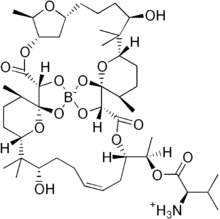Boromycin
 | |
| Systematic (IUPAC) name | |
|---|---|
| [1-{(1R)-1-[(1R,2R,5S,6R,8R,12R,14S,17R,18R,22S,24Z,28S,30S,33R)-12,28-Dihydroxy-1,2,18,19-tetra(hydroxy-kO)-6,13,13,17,29,29,33-heptamethyl-3,20-dioxo-4,7,21,34,35-pentaoxatetracyclo[28.3.1.15,8.114,18]hexatriacont-24-en-22-yl]ethoxy}-3-methyl-1-oxo-2-butanaminiumato(4-)]boron | |
| Clinical data | |
| |
| Identifiers | |
|
34524-20-4 | |
| None | |
| PubChem | CID 6436027 |
| ChemSpider |
16735705 |
| UNII |
49559OZO07 |
| ChEBI |
CHEBI:77880 |
| Chemical data | |
| Formula | C45H74BNO15 |
| 879.878 g/mol | |
|
SMILES
| |
| |
| | |
Boromycin is a bacteriocidal polyether-macrolide antibiotic. It was initially isolated from the Streptomyces strain Streptomyces antibioticus, and is notable for being the first natural product found to contain the element boron. It is effective against most Gram-positive bacteria, but is ineffective against Gram-negative bacteria. Boromycin kills bacteria by negatively affecting the cytoplasmic membrane, resulting in the loss of potassium ions from the cell.
Anti-HIV activity
Recent studies have suggested that boromycin has potent anti-HIV activity. It was found to strongly inhibit the replication of the clinically isolated HIV-1 strain as well as the cultured strain in vitro. The mechanism of action for the anti-HIV activity of boromycin is suggested to involve interfering with the later stage of HIV infection, and possibly the maturation step for the replication of HIV.
References
- Kohno J, Kawahata T, Otake T, Morimoto M, Mori H, Ueba N, Nishio M, Kinumaki A, Komatsubara S, Kawashima K. (1996). "Boromycin, an anti-HIV antibiotic". Biosci Biotechnol Biochem 60 (6): 1036–7. doi:10.1271/bbb.60.1036. PMID 8695905.
- Tom S. S. Chen, Ching-jer Chang, and Heinz G. Floss (1981). "On the Biosynthesis of Boromycin". Journal of Organic Chemistry 46 (13): 2661–2665. doi:10.1021/jo00326a010.
- R. Hütter, W. Keller-Schien, F. Knüsel, V. Prelog , G. C. Rodgers jr., P. Suter, G. Vogel, W. Voser, H. Zähner (1967). "Stoffwechselprodukte von Mikroorganismen. 57. Mitteilung. Boromycin". Helv. Chim. Acta. 50 (6): 1533–1539. doi:10.1002/hlca.19670500612. PMID 6081908.
- J. D. Dunitz, D. M. Hawley, D. Miklo, D. N. J. White, Yu. Berlin, R. Marui, V. Prelog (1971). "Structure of boromycin". Helv. Chim. Acta. 54 (6): 1709–1713. doi:10.1002/hlca.19710540624. PMID 5131791.